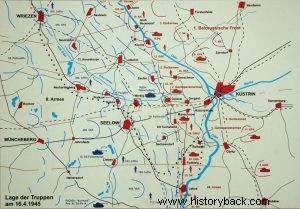
Panzer Division (Panzer Division) "Kurmark" was one of the units of the "last days" of the Hitlerite Third Reich. It was named after the homonymous region of Brandenburg. The division began to be formed in January 1945 from the remnants of the "Langeit Brigade" and the Replacement Brigade of the famous "Grossdeutschand Division".
The division had the 151st Tank Regiment (Spa), the 152nd Grenadier Panzer Regiment (SGRPA), the Panzer Fusiliers Regiment (SFPA), an artillery regiment , an recognition supermajor , a battalion of tank hunters , an engineer battalion, a relay battalion and an anti-aircraft artillery and a motorcycle company.
It is worth noting that the tank hunter battalion had only infantry men equipped with portable anti-tank launchers and no motorized elements. Also the artillery regiment had only two squadrons.
The 125th SGRPA had two under-manned battalions. The SFPA also had two battalions, also of limited strength, but they were joined by the candidate cadet officers who were well trained and maintained high morale. Thanks to the experienced non-commissioned officers of the "Grossdeutschand", satisfactory training was also achieved for the other men, a fact that also had an impact on their morale.
The 151st Infantry Division had two divisions, the first equipped with Panther tanks and the second with a company of Pz IV tanks and three companies of Hetzer tank hunters. The division commander was Colonel Willie Langeit, a distinguished officer, a veteran of Stalingrad.
In battle
Almost immediately after its formation, the "Kurmark" BA entered service and on February 7th it was deployed defensively in the area of Frankfurt on the Oder river, covering a front of 18 km. There he was reinforced with sections of cadets who fought as ordinary soldiers.
In early March the division was ordered to eliminate Soviet bridgeheads in the Rathwein area, but the attack was unsuccessful. At the same time the Soviets succeeded in creating another bridgehead forcing the division to over-extend. It took the deployment of the 712th Infantry Division (IP) to fill the gaps.
The Soviets also attacked from the Rathwein bridgehead and despite the tough defense of the "Kurmark" PA they managed to extend it . Hitler described the villages of Wieden and Klesin as "fortresses" and ordered their defense to the last. The division suffered heavy losses in the battles there and was withdrawn from the front line to reorganize.
But events brought her back, on April 16, to the front, as the great Soviet offensive was launched. The Division was called upon to fight with about 20 Panther tanks, about as many Hetzers and a few Pz IVs – a total of less than 50 tanks and about 5,000 men.
Attached toXI SS Army Corps (which had no SS units) , of the German 9th Army , "Kurmark" battleship fought heroically for three days but was forced to retreat. In the face of overwhelming Soviet superiority the divisions covering the "Kurmark" flanks were disbanded and the division was surrounded.
In the meantime the 9th Army was broken up and its bulk (three army corps) was also encircled. Nevertheless the Germans continued to fight despite being pressed by almost 300,000 Soviet troops, reinforced by 280 tanks and over 7,000 guns and mortars.
Finally, thanks to the attack of the German 12th Army, a part of the 9th Army managed to escape from the Soviet encirclement in the Halbe enclave. Elements of the "Kurmark" also managed to escape and finally surrender to the Americans on May 5, 1945. Its commander, who had meanwhile been promoted to lieutenant general, joined the West German Border Force in 1951.

The order of battle of the southern wing of the German 9th Army.

Colonel (Lt.) Langeit with the men of a Panther tank. The photo says a lot about the spirit that prevailed between command and men in the German army.

